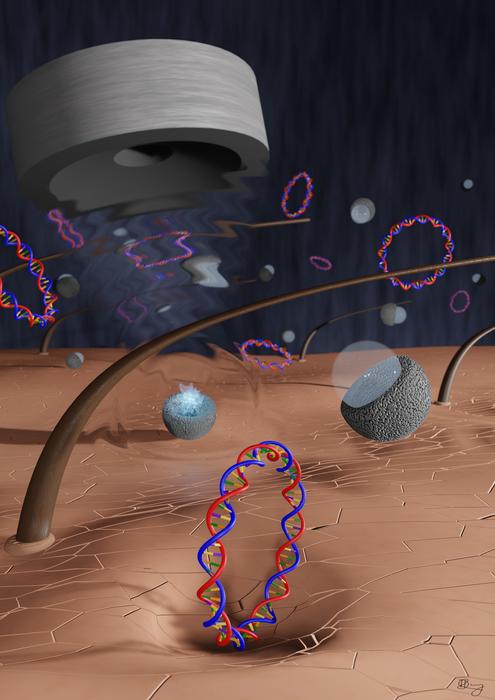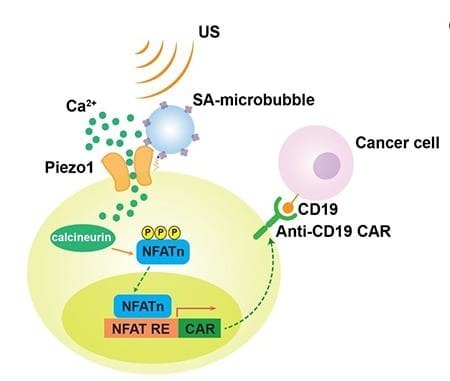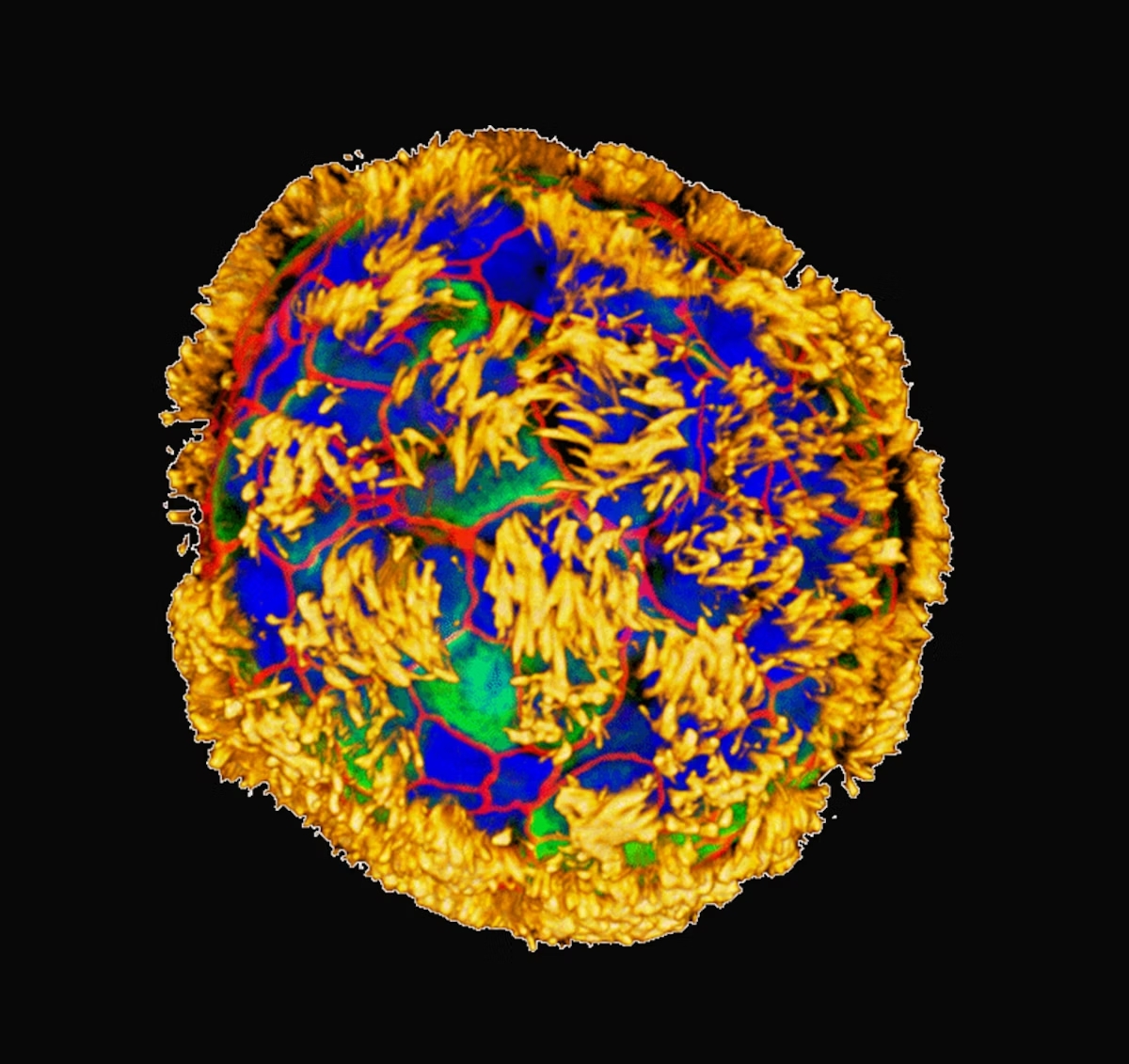
Ultrasound pulses deliver vaccines through the skin without needles. This technique, which employs sound waves to create bubbles that forge a path for the vaccine, may be especially helpful for DNA vaccines.
CREDIT: Darcy Dunn-Lawless
Technique employs bubbles formed and popped in response to sound waves to deliver vaccines and achieve potentially improved immune response.
An estimated quarter of adults and two-thirds of children have strong fears around needles, according to the U.S. Centers for Disease Control and Prevention. Yet, public health depends on people being willing to receive vaccines, which are often administered by a jab.
Darcy Dunn-Lawless, a doctoral student at the University of Oxford’s Institute of Biomedical Engineering, is investigating the potential of a painless, needle-free vaccine delivery by ultrasound. He will share the recent advancements in this promising technique as part of Acoustics 2023 Sydney, running Dec. 4-8 at the International Convention Centre Sydney. His presentation will take place Dec. 4 at 11:00 a.m. Australian Eastern Daylight Time.
“Our method relies on an acoustic effect called ‘cavitation,’ which is the formation and popping of bubbles in response to a sound wave,” said Dunn-Lawless. “We aim to harness the concentrated bursts of mechanical energy produced by these bubble collapses in three main ways. First, to clear passages through the outer layer of dead skin cells and allow vaccine molecules to pass through. Second, to act as a pump that drives the drug molecules into these passages. Lastly, to open up the membranes surrounding the cells themselves, since some types of vaccine must get inside a cell to function.”
Though initial in vivo tests reported 700 times fewer vaccine molecules were delivered by the cavitation approach compared to conventional injection, the cavitation approach produced a higher immune response. The researchers theorize this could be due to the immune-rich skin the ultrasonic delivery targets in contrast to the muscles that receive the jab. The result is a more efficient vaccine that could help reduce costs and increase efficacy with little risk of side effects.
“In my opinion, the main potential side effect is universal to all physical techniques in medicine: If you apply too much energy to the body, you can damage tissue,” Dunn-Lawless said. “Exposure to excessive cavitation can cause mechanical damage to cells and structures. However, there is good evidence that such damage can be avoided by limiting exposure, so a key part of my research is to try and fully identify where this safety threshold lies for vaccine delivery.”
Dunn-Lawless works as part of a larger team under the supervision of Dr. Mike Gray, Professor Bob Carlisle, and Professor Constantin Coussios within Oxford’s Biomedical Ultrasonics, Biotherapy and Biopharmaceuticals Laboratory (BUBBL). Their cavitation approach may be particularly conducing to DNA vaccines that are currently difficult to deliver. With cavitation able to help crack open the membranes blocking therapeutic access to the cell nucleus, the other advantages of DNA vaccines, like a focused immune response, low infection risk, and shelf stability, can be better utilized.
Original Article: Needle-free ultrasound vaccine delivery #Acoustics23
More from: University of Oxford
The Latest Updates from Bing News
Go deeper with Bing News on:
Ultrasound vaccine delivery
- Vaccines News
Mar. 12, 2024 — Researchers have highlighted the importance of continued surveillance of emerging SARS-CoV-2 variants and vaccine performance as the virus continues to ... Optimizing Boosters ...
- Cutaneous Delivery of Prophylactic and Therapeutic Vaccines: Historical Perspective and Future Outlook
The vaccine delivery technology landscape is highly competitive and has been evolving rapidly over the past decade. The technology research environment involves numerous startup companies ...
- Cows' milk particles used for effective oral delivery of drugs
Researchers have found that tiny particles present in cows' milk could offer, for the first time, an effective method for the oral delivery of RNA drugs.
- Oral Vaccine Delivery: Can it Protect Against Non-mucosal Pathogens?
Recent progress in the oral vaccination field and the availability of a range of delivery systems offers hope for the future development of oral vaccines. Studies with Plasmodium parasites ...
- African clinics to get Gates’ new portable ultrasound tech
ALARMING mortality rates in pregnancy-related complications in remote areas of Africa are likely to be reduced in the wake of unveiling ground-breaking, portable ultrasound technology by the Bill & ...
Go deeper with Bing News on:
Ultrasound vaccination
- Good News This Week: April 27, 2024 - Birds, Trains, & Mosquito Nets
Every day the Good Good Good team collects the best good news in the world and shares it with our community. Here are the highlights for this week! If you want to get good news in your inbox every day ...
- Wooster native struggling with possible after-effects of COVID-19 vaccine
She was diagnosed with POTS − Postural Orthostatic Tachycardia Syndrome, a disorder in which the autonomic nervous system doesn't function normally.
- 20 Fastest Growing Health Tech Companies in the World
In this article, we will be taking a look at the 20 fastest growing health tech companies in the world. If you do not want to learn about the trends in digital health market, head straight to the 5 ...
- Zoetis gets grant for vaccine for protecting porcine animals from prrs virus
Protect your porcine animals from PRRS virus with Zoetis Inc's patented vaccine method. Administer before weaning for safe, effective protection.
- African clinics to get Gates’ new portable ultrasound tech
ALARMING mortality rates in pregnancy-related complications in remote areas of Africa are likely to be reduced in the wake of unveiling ground-breaking, portable ultrasound technology by the Bill & ...










